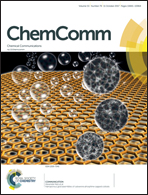Site-selective tagging of proteins by pnictogen-mediated self-assembly†
Abstract
Site-selective chemical protein modification is achieved by self-assembly of a specific di-cysteine motif, trivalent pnictogens (As, Sb or Bi) and an aromatic mercaptomethyl-based probe. The strategy is demonstrated with a quaternary complex involving Zika virus protease and a lanthanide ion, enabling paramagnetic nuclear magnetic resonance spectroscopy and luminescence measurements.



 Please wait while we load your content...
Please wait while we load your content...